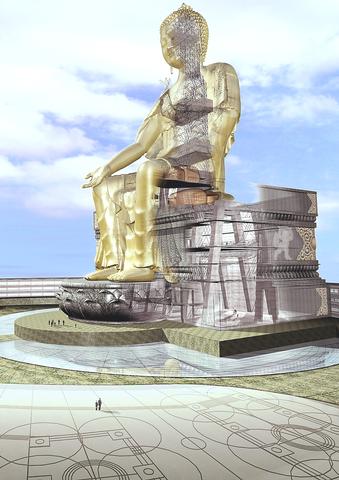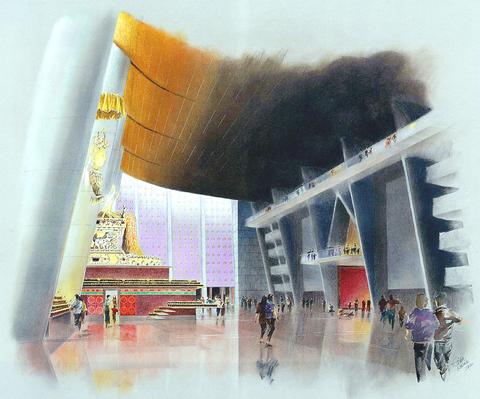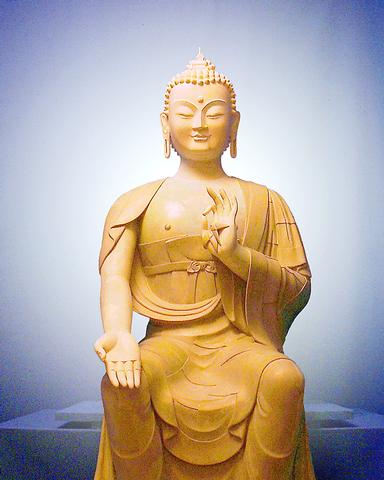It would be difficult to guess that the small office of Maitreya Project International (彌勒大佛工程台灣辦事處), hidden away in the warren of alleys off Nanking East Road Section 4, was an important cog in an international project to build the biggest Buddha statue in the world. Their presence is unremarkable, but their ambition, to erect a statue that will stand 152.4m tall in the town of Bodhgaya, India, is enormous.
Taiwan's participation in the project goes far beyond the country's small size and isolation, being the source of over one third of the funding.
"The largest supply of funds comes from the US," said Peter Kedge, the director of the project, "but Taiwan's contribution has been over 30 percent."

PHOTO COURTESY OF THE MAITREYA PROJECT
"The very idea to make the image so big came from an architect in Taiwan," Kedge said, adding that they settled on the round number of 500 feet (152.4m) during a visit by Lama Thubten Zopa Rinpoche to Taiwan five years ago.
Lama Zopa is the spiritual director of the Foundation for the Preservation of the Mahayana Tradition, a leading sponsor of the Maitreya Project. Since that visit, many Taiwanese have donated money and time to the project. Kedge said Taiwan had played an important role in sustaining Buddhism, in large part because of its considerable financial resources. "From my observation, when Taiwanese make a commitment, they make it with directness."
While declining to name any names, Kedge said that much of the support came from individuals rather than institutions. According to Monica Choying, at an event last November during a visit by Lama Osel, who is believed to be the reincarnation of Lama Yeshe, the initiator of the Maitreya Project, the organizers raised US$100,000 in a single evening.

PHOTO COURTESY OF THE MAITREYA PROJECT
Kedge, an engineer who has worked extensively in the UK and Hong Kong, is one of a growing number of Western Buddhists active around the world in the name of the religion. "Thirty years ago, when I first became interested in Buddhism, you could find perhaps five or six English books on the subject [in bookstores in Nepal]. Now there are thousands of titles available," Kedge said.
He said no definitive figures were available on the number of converts to Buddhism, but pointed to the huge increase in publications as proof at least of growing interest.
For this reason, the Maitreya Project has been careful to avoid associations with any one country or sect within Buddhism. While the inspiration for the project came from Lama Thubten Yehshe, the statue that he proposed is intended to express the qualities of the Maitreya Buddha -- compassion and living kindness -- for people of all sects. Kedge pointed out that, probably for the first time in such a project, much of the artistic work will be carried out by people not of Asian decent. "I am glad we chose British contemporary religious artists," Kedge said, adding that the Buddha would adhere to the traditional proportions, but would not be clearly recognizable as belonging to any specific regional style. The prototype is the creation of Denise Griffin, who began work on the figure in Taiwan in 1997.

PHOTO COURTESY OF THE MAITREYA PROJECT
Despite the use of high technology in many aspects of the project, the construction of such a massive religious image seems to harken back to an earlier age. Kedge agrees. "In ancient times, the skyline was dominated by monuments to religion, but now the essential human qualities that they represented are being overshadowed by the demands of an urban, industrialized lifestyle."
He said he felt some initial hesitation toward the project. "Initially I was thinking only about the statue," he said "and something from my Christian upbringing balked at it. ... Gradually, as I have lived with and constantly thought about the project, it has become clear that it is the most brilliantly conceived method to benefit living beings."
Despite its enormous size, the project organizers have decided to cast the statue in bronze, because "it must last for 1,000 years."
Kedge said the statue poses enormous technical challenges. Metallurgist Rudy Hardervijk said that there were few with the technical expertise to create the required large plates of bronze of sufficient structural strength.
Many visits have been made to sites of other monumental statues, including visits with Robert Landsman, the man who had been project manager for the restoration of the Statue of Liberty (46m), and the managers of the Ushiku statue in Tokyo (120m).
Special emphasis has been placed on ensuring the statue helps transform the town of Bodhgaya, a holy site for Buddhists, but which is disintegrating under grinding poverty. According to Choying, some locals had asked why it was necessary to build a statue so far away, rather than in Taiwan, where it would be more convenient to visit and make offerings. Her response was that having the statue built in that holy place would benefit Buddhists all over the world rather than just Taiwanese.
According to Kedge, much of the preliminary work has been completed, and the group aims to complete the whole project by the end of 2005. In a report in The Observer newspaper on May 13, the Chinese government had announced that it would complete a huge Buddha that would stand 2.7m higher than the Bodhgaya statue. Kedge dismissed any idea that there is competition between the Maitraya Project and the Chinese government and simply said that "if we have inspired them to such a project, this should be reason for joy."
To learn more about the Maitreya Project check out http://www.maitreyaproject.org/home/index.html

April 14 to April 20 In March 1947, Sising Katadrepan urged the government to drop the “high mountain people” (高山族) designation for Indigenous Taiwanese and refer to them as “Taiwan people” (台灣族). He considered the term derogatory, arguing that it made them sound like animals. The Taiwan Provincial Government agreed to stop using the term, stating that Indigenous Taiwanese suffered all sorts of discrimination and oppression under the Japanese and were forced to live in the mountains as outsiders to society. Now, under the new regime, they would be seen as equals, thus they should be henceforth

Last week, the the National Immigration Agency (NIA) told the legislature that more than 10,000 naturalized Taiwanese citizens from the People’s Republic of China (PRC) risked having their citizenship revoked if they failed to provide proof that they had renounced their Chinese household registration within the next three months. Renunciation is required under the Act Governing Relations Between the People of the Taiwan Area and the Mainland Area (臺灣地區與大陸地區人民關係條例), as amended in 2004, though it was only a legal requirement after 2000. Prior to that, it had been only an administrative requirement since the Nationality Act (國籍法) was established in

With over 80 works on display, this is Louise Bourgeois’ first solo show in Taiwan. Visitors are invited to traverse her world of love and hate, vengeance and acceptance, trauma and reconciliation. Dominating the entrance, the nine-foot-tall Crouching Spider (2003) greets visitors. The creature looms behind the glass facade, symbolic protector and gatekeeper to the intimate journey ahead. Bourgeois, best known for her giant spider sculptures, is one of the most influential artist of the twentieth century. Blending vulnerability and defiance through themes of sexuality, trauma and identity, her work reshaped the landscape of contemporary art with fearless honesty. “People are influenced by

Three big changes have transformed the landscape of Taiwan’s local patronage factions: Increasing Democratic Progressive Party (DPP) involvement, rising new factions and the Chinese Nationalist Party’s (KMT) significantly weakened control. GREEN FACTIONS It is said that “south of the Zhuoshui River (濁水溪), there is no blue-green divide,” meaning that from Yunlin County south there is no difference between KMT and DPP politicians. This is not always true, but there is more than a grain of truth to it. Traditionally, DPP factions are viewed as national entities, with their primary function to secure plum positions in the party and government. This is not unusual